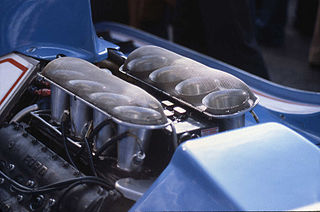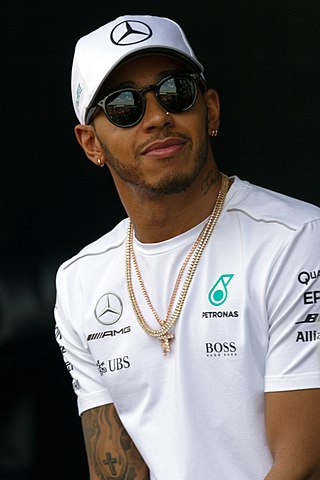Formula One is the highest class of international racing for open-wheel single-seater formula racing cars sanctioned by the Fédération Internationale de l'Automobile (FIA). The FIA Formula One World Championship has been one of the premier forms of racing around the world since its inaugural season in 1950. The word formula in the name refers to the set of rules to which all participants' cars must conform. A Formula One season consists of a series of races, known as Grands Prix. Grands Prix take place in multiple countries and continents around the world on either purpose-built circuits or closed public roads.

Cosworth is a British automotive engineering company founded in London in 1958, specialising in high-performance internal combustion engines, powertrain, and electronics for automobile racing (motorsport) and mainstream automotive industries. Cosworth is based in Northampton, England, with facilities in Cottenham, England, Silverstone, England, and Indianapolis, IN, US.

Lotus Cars Limited is a British automotive company headquartered in Norfolk, England, which manufactures sports cars and racing cars noted for their light weight and fine handling characteristics. The engineering consultancy firm Lotus Engineering, an offshoot of Lotus Cars, has facilities in the United Kingdom, United States, China, and Malaysia.

Formula One automobile racing has its roots in the European Grand Prix championships of the 1920s and 1930s, though the foundation of the modern Formula One began in 1946 with the Fédération Internationale de l'Automobile's (FIA) standardisation of rules, which was followed by a World Championship of Drivers in 1950.
A Formula One car or F1 car is a single-seat, open-cockpit, open-wheel formula racing car with substantial front and rear wings, and an engine positioned behind the driver, intended to be used in competition at Formula One racing events. The regulations governing the cars are unique to the championship and specify that cars must be constructed by the racing teams themselves, though the design and manufacture can be outsourced. Formula One cars are the fastest cars in the world around a race track, owing to very high cornering speeds achieved through the generation of large amounts of aerodynamic downforce. Due to the amount of braking force and the total cornering envelope of a Formula One car, Formula One drivers experience frequent lateral g-loadings in excess of five g and peak cornering forces of up to seven lateral g.

Robert August "Bob" Varsha is an American broadcast journalist who specializes in covering motorsports. He is best known for being the lap-by-lap commentator for Formula 1 and CART series races for ESPN, ABC Sports, and Speed Channel among others.

Steve Matchett is a commentator for American TV network Fox Sports on its Formula E programming. He formerly co-hosted live Formula One practices, qualifying sessions, and races alongside David Hobbs and Bob Varsha.

The Lotus 78 was a Formula One racing car used in the 1977 and 1978 seasons. It was designed by Peter Wright, Colin Chapman, Martin Ogilvie and Tony Rudd, and was the first ground effect car in Formula One.

The GP2 Series was a form of open wheel motor racing introduced in 2005 following the discontinuation of the long-term Formula One feeder series, Formula 3000. The GP2 format was conceived by Bernie Ecclestone and Flavio Briatore, while Ecclestone also has the rights to the name GP1. The series was organized by Bruno Michel. In 2010, the GP3 Series class was launched, as a feeder class for the GP2 series. In 2017, the series was rebranded as the FIA Formula 2 Championship.

The Brabham BT46 is a Formula One racing car designed by Gordon Murray for the Brabham team, owned by Bernie Ecclestone, for the 1978 Formula One season. The car featured several radical design elements, one of which was the use of flat panel heat exchangers on the bodywork of the car to replace conventional water and oil radiators. It was removed before the car's race debut, never to be seen again. The cars, however, powered by a flat-12 Alfa Romeo engine, raced competitively with modified nose-mounted radiators for most of the year, driven by Niki Lauda and John Watson, winning one race in this form and scoring sufficient points for the team to finish third in the constructors championship.

The Brabham BT49 is a Formula One racing car designed by South African Gordon Murray for the British Brabham team. The BT49 competed in the 1979 to 1982 Formula One World Championships and was used by Brazilian driver Nelson Piquet to win his first World Championship in 1981.
F1 Digital+ was the name of the enhanced world feed package for Formula One coverage that existed from 1996 to 2002.

RaceCam is a video camera system used primarily in motor racing, which uses a network of car-mounted cameras, microwave radio transmitters, and relays from helicopters to send live images from inside a race car to both pit crews and television audiences.
Side-by-side is a type of split-screen presentation format used on television broadcasts, particularly as a means of continuing to show a view of ongoing live content, whilst simultaneously airing commercials alongside them. Typically, only the audio of the advertising is played.
The regulations governing Formula One racing have changed many times throughout the history of the sport.

ESPN SpeedWorld is a former television series broadcast on ESPN from 1979 to 2006. The program that was based primarily based around NASCAR, CART, IMSA, Formula One, NHRA, and IHRA. The theme music is based on the piano interlude from "18th Avenue " by Cat Stevens.
Sky Sports F1 is a television channel created exclusively for Sky's UK and Ireland coverage of Formula One, with Sky having a package of rights from the 2012 season to the 2029 season. From 2012 to 2029, Sky Sports F1 has the exclusive rights to broadcast Formula 1 live in the UK and Ireland, and will sub-licence highlights of all races and qualifying sessions plus the British Grand Prix live to Channel 4. Since 2017, Sky Sports F1 has broadcast Formula 1 in 4K UHD.
ITV held the rights to show Formula One races in the United Kingdom between 8 March 1997 and 2 November 2008.

The 2018 FIA Formula One World Championship was the motor racing championship for Formula One cars and the 69th running of the Formula One World Championship. Formula One is recognised by the governing body of international motorsport, the Fédération Internationale de l'Automobile (FIA), as the highest class of competition for open-wheel racing cars. Drivers and teams competed in twenty-one Grands Prix for the World Drivers' and World Constructors' championship titles.












